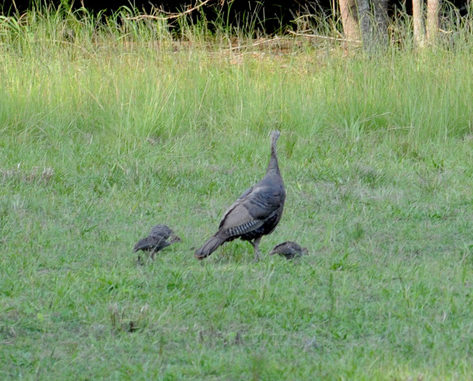
Poult survival matches worst years on record, NCWRC survey indicates
The N.C. Wildlife Resources Commission’s annual wild turkey summer brood survey has some really bad news for turkey hunters: poult survival this past summer matched an all-time low.
Evin Stanford, the biologist who oversees wild turkeys for the Commission, said the survey – in which observers reported seeing 31,745 wild turkeys during July and August – indicates poor nesting success, poor to fair poult survival and poor overall productivity.
“Statewide, the percentage of hens with poults (51) indicates poor nesting success,” Stanford said. “The ratio of poults/hens observed with poults (3.1) indicates poor-to-fair poult survival and the ratio of poults to hens (1.6) indicates poor overall productivity.
“Overall productivity is determined by the ratio of poults/hen. A ratio of 2.5 poults per hen is considered good productivity. That means statewide productivity has been at the lowest levels ever documented for two consecutive years.”
Stanford noted the 2013 statewide productivity index matched the previous record low values, observed in 2012 and 2003.
North Carolina had an unusually wet, cool early summer, a situation which takes its toll on turkey poults that are susceptible to hypothermia their first several weeks of life. The survey reported poor overall results across most of the state.
The Coastal region experienced fair nesting success (57 percent of hens with poults), fair survival (3.2 pouts per hens with poults) and poor overall productivity (1.8 poults per hen). The Piedmont region experienced even worse nesting success (45), fair poult survival (3.2) and a record low for poor overall productivity (1.4). The mountains had poor-to-fair nesting success (55), poor poult survival (3.0) and poor overall productivity (1.7).
Oddly, the observed ratio of gobbler-to-hens observed indicated an elevated carryover level of gobblers from 2012. A ratio of less than 0.50 gobblers/hen may be an indication of overharvest of male birds, if quality spring gobbler hunting is the management goal. In 2013, North Carolina saw a record high of 0.62 gobblers per hen, agove the 0.54 average over the past five years.
“These long-term data indicated that if quality spring gobbler hunting is to be maintained, additional pressure should not be placed on the male segment of the wild turkey population by increasing the season length, opening the spring season earlier or increasing the bag limit,” Stanford said.




Be the first to comment